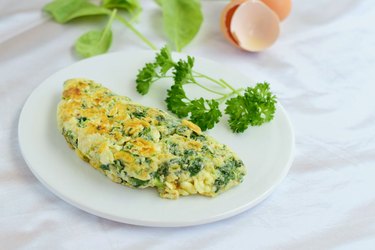
You've been hitting the weights regularly to build muscle, but now you want to take your fitness plan one step further to really define those abs and triceps. That means it's time to focus on your nutrition and shed some pounds.
The good news? You don't have to starve yourself to get ripped — but you do need to pay careful attention to what and how much you eat. The key to a get-ripped diet plan is cutting calories while still getting the right balance of nutrition, which will help you lose fat and maintain your hard-earned muscle.
Video of the Day
Video of the Day
Cut Down Your Calories
When it comes to losing weight, doctors recommend a healthy pace of about one to two pounds per week. According to a May 2014 review published in the Journal of the International Society of Sports Nutrition (JISSN), decreasing your daily calorie intake by about 500 calories should help you lose about a pound each week. However, your specific daily calorie needs will depend on your current intake and activity level. If you're not losing weight or you're losing weight too quickly, you may need to subtract or add 100 to 200 daily calories, respectively.
Get the Right Balance of Carbs, Protein and Fat
The best diet for getting ripped is high in protein and low in fat, with a moderate amount of carbs. Active individuals must be careful to eat enough protein to preserve lean muscle mass. According to the researchers behind the 2014 JISSN review, that translates to 2.3 to 3.1 grams of protein per kilogram of body weight. So, for example, a 175-pound person would need to eat somewhere between 183 and 247 grams of protein each day (a lot more than the 50 or so grams the Food and Drug Administration recommends most people get in a day).
Fat should account for 15 to 30 percent of your overall calories, and the rest of your nutrients should come from carbs. So your calorie breakdown might look like this: 45 percent from protein, 35 percent from carbs and 20 percent from fat.
Eat to Get Ripped
Your ripped-body diet plan should include three to six meals a day. The International Society of Sports Nutrition recommends spacing your protein intake throughout the day, eating about every three hours. And keep in mind that you should consume a high-protein meal before a strength-training session to maximize muscle growth, according to the JISSN review.
When restricting calories, make the most nutritious food choices to ensure you're meeting your body's vitamin and mineral needs. A healthy, get-ripped diet should include lean sources of protein such as poultry, fish, egg whites and tofu. You should also aim to incorporate fruits and vegetables, whole grains and low-fat dairy.
Tip
Make protein the center of each meal to ensure you're getting enough.
Sample Meal Plan
Breakfast:
- Six-egg-white omelet filled with 1/2 cup of spinach cooked in 1 teaspoon of oil
- One serving of nonfat yogurt
Lunch:
- 6 ounces of grilled tuna on top of 3 cups of mixed greens with balsamic vinegar and 2 teaspoons of olive oil
- Small apple
- 1 cup of brown rice
High-protein pre-workout meal:
- 6 ounces grilled chicken breast
- 1 cup of cherry tomatoes, peppers and mushrooms served kebab style
- 1 cup of nonfat milk
Dinner:
- 6 ounces of roasted turkey breast
- 2 cups of broccoli sautéed in 1 teaspoon of oil
- 1 cup of a baked sweet potato
This meal plan contains 1,780 calories and 196 grams of protein.
- Journal of the International Society of Sports Nutrition: "Evidence-Based Recommendations for Natural Bodybuilding Contest Preparation: Nutrition and Supplementation"
- Mayo Clinic: "Why do doctors recommend a slow rate of weight loss? What's wrong with fast weight loss?"
- National Center for Biotechnology Information: "International society of sports nutrition position stand: nutrient timing"